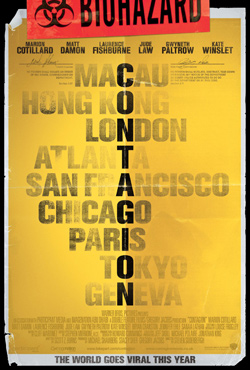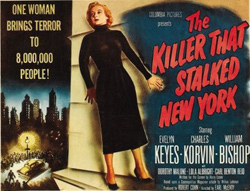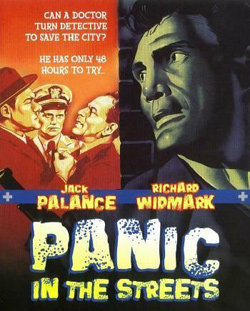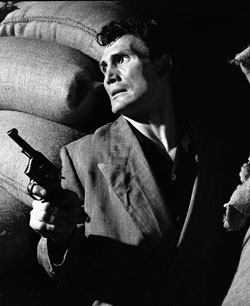
Why does America produce these kinds of films? To find the roots of our recent anxiety, one might point to the usual suspects: the HIV-AIDS epidemic, ill-informed paranoia about vaccines, fears of biological terrorism, media-hyped scares about various new forms of influenza. But, of course, movies about the end of the world are nothing new. After all, Will Smith’s I Am Legend is just the latest adaptation of Richard Matheson’s novel of the same name (Previous versions included 1964’s The Last Man on Earth, and the 1971 The Omega Man). And that book came out in 1954.
As it turns out, the 1950s were a good time to publish a novel about the end of humanity. America, deep in the Cold War, had a deep fear of contamination from outside sources. Even in unspoiled suburbia, the fear of infiltration triggered deep anxieties. The cleaner the surface, the more fear bubbling underneath. As is usually the case when talking about this period of American culture, you can look to film noir for an indication of what was boiling in the American subconscious.
Take two films from 1950, both of which deal directly with contagion:

Director Earl McEvoy keeps things moving without letting us get confused, while the cinematography by Joseph Biroc is a nice blend of location footage in New York and some atmospheric soundstage work—such as Shelia’s final confrontation with her shiftless husband. Evelyn Keyes (99 River Street ) is as good as ever as the vengeful Shelia, though because she’s unaware she’s carrying the disease for most of the film, she doesn’t have a whole lot to do. To make up for this last problem, the script by Harry Essex builds suspense around the emerging smallpox epidemic. These scenes are all business, with doctor William Bishop and nurse Dorothy Malone confronting a quickly mounting number of cases. One of the purposes of a movie like this is to function as a public service announcement, and I’ll be damned if this one didn’t work on me. Human beings are nasty creatures, so thank god for the Centers for Disease Control.

This basic situation isn’t too different from The Killer That Stalked New York (and not too different from all the dramas about epidemics which have followed). We get the usual heated debates about whether or not to inform the public of the danger and take chances with, well, panic in the streets. Ironically, given the title of this film, the characters decide not to make the danger public, so the title is a vivid description of something that doesn’t happen in the movie.
Whereas Killer is concerned with the actual ins and outs of dealing with an epidemic, Panic In The Streets keeps its drama focused on suspense and the passions of the characters. The film was something of an experiment for director Elia Kazan, who wanted to prove that he could direct visually impressive entertainment, as opposed to the more character-based work for which he was famous. His chief collaborator on the film was cinematographer Joe MacDonald, who created painterly images with deep blacks and stark whites. Using deep focus, Kazan utilizes the entire frame, letting action unfold on different planes. Just look at the scene at the beginning of the film in which Blackie and his boys kill the infected man. It’s one extremely long take that covers a lot of ground, involves four actors and a train, and is gorgeous black and white.

So Contagion, in theme, is nothing new. It remains to be seen what kind of a spin Soderbergh can put on it.
Jake Hinkson, The Night Editor

The first sort of “contagion” movie I remember seeing was as much sci-fi as anything. The Andromeda Strain, which I saw at the age of 8, gave me nightmares for ages. Dead towns, people turning to dust…scared the crap out of me.
You know, I suppose if you look at it from a certain point of view any fiction film that is based around science is technically a science fiction film.
And, yeah, Andromeda Strain is a pants-crapper.
heh…The Happening…”What A Twist!”
I still say that The Red Scare was almost a golden age for genre fiction. I mean the Rosenberg Trial alone provided plenty of “Other” fear/don’t trust your neighbor for a good decade or so.
True true true. Your comment reminded me of Welles’s speech in The Third Man:
Like the fella says, in Italy for 30 years under the Borgias they had
warfare, terror, murder, and bloodshed, but they produced Michelangelo, Leonardo da Vinci, and the Renaissance. In Switzerland they had brotherly love – they had 500 years of democracy and peace, and what did that produce? The cuckoo clock.